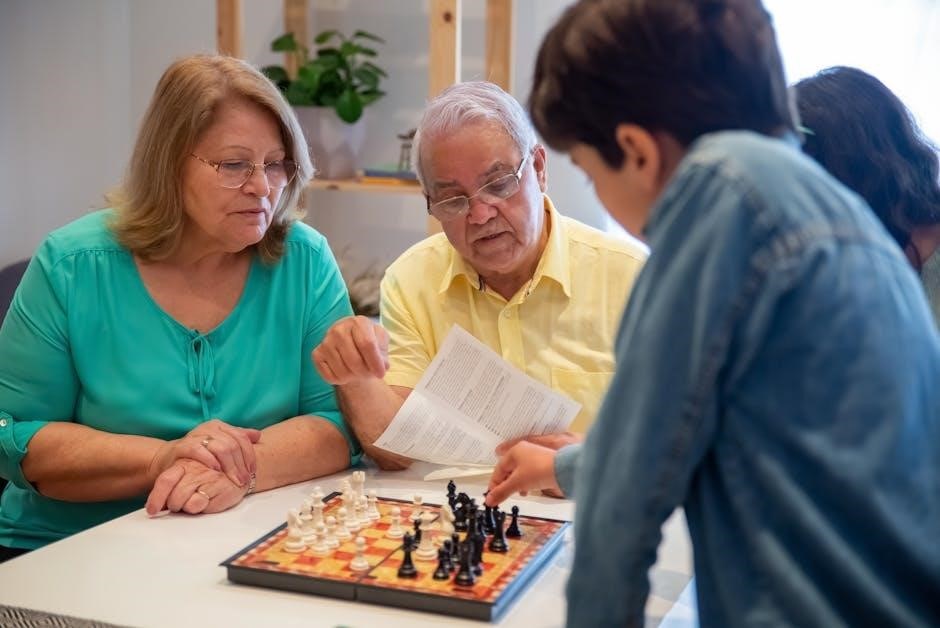Understanding the Racko Game
Racko is a Milton Bradley sequential-matching card game where players aim to arrange cards in numerical order. The objective is to be the first to organize 10 cards in ascending order, from lowest to highest.
Overview of the Game
Racko is a popular Milton Bradley sequential-matching card game designed for 2 to 4 players, ideal for family fun and strategic thinking. The game uses a unique deck of 60 cards numbered from 1 to 60, and players are provided with plastic racks to organize their cards. The objective is to arrange the cards in numerical order, from the lowest number at the front of the rack to the highest at the back. Each player starts with 10 randomly dealt cards and takes turns drawing new cards to improve their sequence. The game combines luck and strategy, as players must decide which cards to keep and which to discard to achieve the best possible order. Racko is beloved for its simplicity and engaging gameplay, making it accessible to players of all ages and skill levels. Its straightforward rules and exciting challenges ensure it remains a timeless favorite for gatherings and casual play.
Objective of the Game
The primary objective of Racko is to be the first player to arrange all 10 cards in your rack in ascending numerical order, from the lowest number at the front to the highest at the back. This is achieved by strategically replacing cards in your rack with new ones drawn from the deck or discarded by other players. The game rewards both luck and strategic thinking, as players must decide which cards to keep and which to discard to work toward the perfect sequence. The first player to achieve this order, known as “Rack-O,” wins the game. In some variations, the game continues until a player reaches a predetermined score, such as 500 points, adding an extra layer of competition. The objective emphasizes quick decision-making and tactical card management, making Racko a simple yet engaging experience for players of all ages.

Setting Up the Game

To set up Racko, shuffle the 60-card deck and deal 10 cards to each player, placing them in their racks. The remaining cards form the draw pile, and the game is ready to begin.
Equipment Needed
To play Racko, you’ll need a few essential components. The game requires a deck of 60 cards, numbered from 1 to 60, which are used to build sequences. Each player also needs a plastic Rack-O rack, which holds 10 cards. These racks are designed to allow players to organize and rearrange their cards easily. Additionally, a card tray is provided to manage the deck and discard pile. For scoring, you’ll need a paper and pencil to keep track of points. The game also includes an instruction manual to guide players through the rules and setup. For younger players, there’s a Rack-O Jr. version with a simplified deck and rules. Ensure all components are accounted for before starting to ensure smooth gameplay. The equipment is straightforward, making Racko accessible to players of all ages.
Dealing the Cards
The game begins by dealing the cards to each player. In a standard Racko game, each player receives 10 cards. For a 3-player game, only cards numbered 1 through 50 are used, and Prime cards are excluded. Each player is dealt cards in a specific order, which they place into their rack. The first card goes into slot 50, the second into slot 45, and so on, with the tenth card placed in slot 5. This initial arrangement sets the foundation for the game. In a 4-player game, all 60 cards are used, and each player still receives 10 cards. The card tray is placed in the center of the table, with one side for drawing cards and the other for discarding. Players should keep their cards private at the start, as the challenge is to rearrange them into the correct order. Proper dealing ensures a fair and organized beginning to the game.

Gameplay Rules
Players draw or discard cards each turn to replace cards in their rack. The goal is to arrange cards in ascending numerical order, ensuring all 10 cards are sequenced correctly to win the game.
Basic Rules
In Racko, each player starts with a rack of 10 cards dealt randomly. The goal is to arrange these cards in ascending order, from the lowest number at the front of the rack to the highest at the back. Players take turns drawing a card from the deck or the discard pile and may choose to replace one card in their rack with the new card. The game continues until a player achieves the correct numerical sequence, shouting “Racko” to win. Key rules include:
- Each player must manage their rack strategically, replacing cards to achieve order.
- Only one card can be drawn or discarded per turn.
- The game ends immediately when a player’s rack is fully ordered.
- Scoring is based on the numbers in the rack at the end of the game.
These rules ensure a balanced mix of strategy and luck, making Racko enjoyable for players of all ages.

Special Rules and Variations

Racko offers several variations to enhance gameplay and cater to different player preferences. In a 3-player game, only cards numbered 1 through 50 are used, and all Prime card special powers are ignored. Additionally, the game can be played to a higher score of 500 points for a quicker match. Another variation is Bonus Rack-O, where players earn extra points for having sequences of 3 to 6 cards in numerical order before going Racko. Some versions introduce a “double rack” system, where players aim to line up 8 red and 8 blue cards in ascending order on either side of the rack. Special setup rules include placing the card tray in the center of the table and dealing cards in a specific order, such as inserting the first card in slot 50, the second in slot 45, and so on. These variations add complexity and excitement to the classic game.

Scoring and Winning
The goal is to score points by arranging cards in numerical order. Points are awarded based on the sequence achieved. The first player to reach the target score wins the game.
How to Score Points
In Racko, scoring is based on the numerical order of cards in your rack. Points are awarded for each card that is in the correct sequence, starting from the lowest number at the front to the highest at the back. Each card in the proper order adds to your score, while cards out of sequence do not contribute. Bonus points are awarded for sequences or runs of 3 to 6 cards in ascending order. The game ends when a player reaches the target score, typically 500 points. If multiple players exceed the winning score, the highest total wins. Strategic card replacements and maintaining sequences are key to maximizing your score.
Winning Conditions
The game of Racko ends when a player reaches the designated winning score, typically 500 points. The first player to accumulate this score is declared the winner. If multiple players exceed the winning score in the same round, the player with the highest total points wins. The objective is to be the first to arrange all 10 cards in your rack in ascending numerical order, from the lowest number at the front to the highest at the back. This is known as going “RACK-O.” Players must strategically replace cards in their racks to achieve this goal. The game also allows for variations, such as quick games where the target score is lower, making it faster to determine a winner. Winning conditions may vary slightly depending on the version of the game being played.





